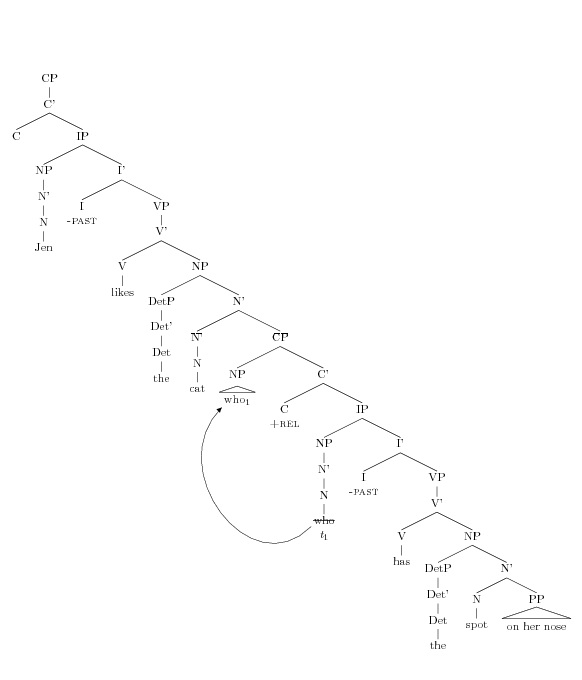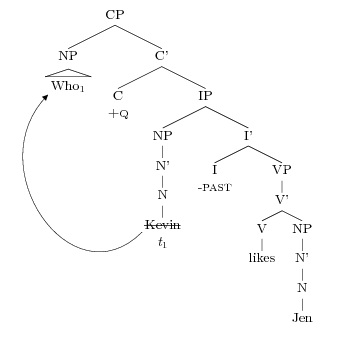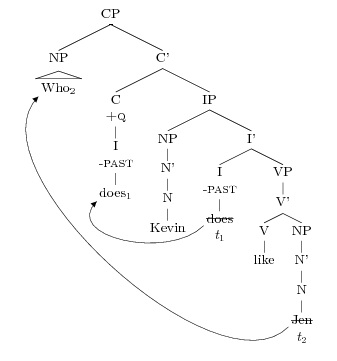Amy Reynolds
Linguistics PhD student, UNC-Chapel Hill
Drawing Question Syntax Trees
Now that you have learned how to deal with basic X-bar structure and drawing sentence syntax trees, you can easily learn how to deal with questions, and other forms of movement (i.e. relative clause CPs).
Step 1: Imagine the Answer (i.e. the original structure)
When you first encounter a question, first think about what the complete answer would be (in a “Who stole the cookies from the cookie jar” game way).
For example, below is a list of example questions and full sentence responses:
| Question | Answer |
| 1) a. Who laughs? | b. Alice laughs. |
| 2) a. Who likes Jen? | b. Kevin likes Jen. |
| 3) a. Who does Kevin like? | b. Kevin likes Jen. |
| 4) a. Who should Picard punch in the face? | b. Picard should punch Riker in the face. |
| 5) a. Who should punch Riker in the face? | b. Picard should punch Riker in the face. |
| 6) a. Where should Picard punch Riker? | b. Picard should punch Riker in the face. |
| 7) a. What should Picard punch Riker with? | b. Picard should punch Riker with his fist. |
As you can see from the above examples, multiple questions can be made from the same assumed Deep Structure, all that is changing is what movement is occurring on its way to the Surface Structure. In syntax, we assume that every question starts out the same way that a sentence does in the Deep Structure (except for a feature on C), but that movement occurs when it transitions to Surface Structure. On that transition to the surface structure, because each of these sentences has a +Q feature in the head of the overall CP, movement must occur to satisfy it, hence the different questions.
So let’s begin with a simple question like Who laughs?
As we can see from above, we would expect the answer to have been something like Alice laughs. So we would assume that the deep structure starts out like in (1a) below:
(1a)
Note the close similarity between (1a) and (1b). The only difference structure-wise is that there is a +Q feature in the C position of (1a), and not in (1b). This hints to us that (1a) will show movement in it’s surface structure, while the constituents in (1b) will remain in their original positions.
So what about the other questions described above? The same principle applies. The deep structure is assumed to have the same structure as the corresponding answers would have, except that there should be a +Q feature occuring in the C of the Questions, and different constituents will be headed by question words. Now all that is left is to show the movement.
Step 2: Show the movement
The similarity of the sentence Alice laughs with Who laughs can be a bit deceptive when it comes to the surface structure. This is because while in the Deep Structure, they are very similar, the NP appears in different positions in the surface structure of the two. This is because, as noted, movement occurs in who laughs so that the +Q feature of C is satisfied. There are three types of movement in questions, and only two relevant for English: NP to spec CP movement (i.e. wh-movement) and I to C movement (i.e Inversion). The third is V to I movement, which is covered in your book, and since we are covering the basics primarily for English here, we will not be discussing.
In the instance of Who laughs, we have a case of wh-movement, although there isn’t an obvious change in word order. We know this because there is a +Q feature that needs to be satisfied. Also, since there is a “wh-word”, we know that there has to be movement. In this case, the following movement occurs from the deep structure shown in (1a):
(2)
In (2), the entire NP has moved to the spec CP position, leaving behind a trace.
For the questions about the sentence Kevin likes Jen, we once again have two instances of wh-movement, although in these cases, the NP that is moving is occuring in two different locations:
(3a)
In (3a), we see that the movement that has occurred from the subject NP to the spec CP position is the same as in (2). In (3b), we actually see two types of movement to form the question Who does Kevin like: we have wh-movement, moving the direct object NP who to the spec CP position, as well as do-insertion and subsequent inversion so that does appears in the C position. Note that whenever a movement occurs, there is a trace left behind. It is often most useful to add a subscript to denote which traces coordinate with which moved elements.
Other types of movement
While this page has primarily been focusing on the movement within questions, there are other places where we assume that movement has occurred. As mentioned earlier, there is also movement that occurs within relative clause CPs. Relative clauses are clauses which provide further information about NPs, in the form of miniature sentences. Some examples are:
Jen likes the cat who has a spot on her nose.
I know the girl who Sam met at the party.
I know the object which Miss Scarlet killed Professor Plum with.
These three sentences show when movement in the relative clause has occurred, with the original element having moved from the subject, direct object, and indirect object position. The process for thinking about the movement in these clauses are very similar to that of questions. Essentially, the relative clause is a tiny CP, which acts like a miniature question. Note that you can answer the question (or similar question) posed in each of these relative clauses with the NP that those relative clauses are modifying:
| Question | Answer |
| Who has the spot on her nose? | The cat. |
| Who did Sam meet at the party? | The girl. |
| What did Miss Scarlet kill Professor Plum with? | The object. |
Because they are similar to miniature questions, we expect them to similarly show movement. We can tell where the question words originate, once again, by thinking about the original small sentence statements:
| Question | Answer |
| Who has the spot on her nose? | The cat has the spot on her nose. |
| Who did Sam meet at the party? | Sam met the girl at the party. |
| What did Miss Scarlet kill Professor Plum with? | Miss Scarlet killed Professor Plum with the object. |
Once again, then, we assume that the underlying structure has the question word originating in the position that the NP originated in the smaller CP structure. The main difference is that movement is motivated by a +Relative feature, rather than a +Q feature. So assume that the deep structure of the Relative Clause is like that of (4) below:
(4)
 We then assume that the wh-word, which happens to be in the subject position of the relative clause of (4), moves up to satisfy the +Rel feature in the relative clause, as in (5):
We then assume that the wh-word, which happens to be in the subject position of the relative clause of (4), moves up to satisfy the +Rel feature in the relative clause, as in (5):
(5) The final step for drawing your tree is easy — simply add the higher part of the sentence (Jen likes the cat), with the Relative Clause CP that we have just developed attaching as the modifier of the NP the cat, as in (6):
The final step for drawing your tree is easy — simply add the higher part of the sentence (Jen likes the cat), with the Relative Clause CP that we have just developed attaching as the modifier of the NP the cat, as in (6):
(6) The structure of the other relative clause examples given above differ primarily in the location of the NP being moved within the relative clause’s structure. But as we can see, once we have understood the basics of movement within questions, it is easy to make the leap to understanding movement within relative clauses.
The structure of the other relative clause examples given above differ primarily in the location of the NP being moved within the relative clause’s structure. But as we can see, once we have understood the basics of movement within questions, it is easy to make the leap to understanding movement within relative clauses.






University Operator: (919) 962-2211 | © 2024 The University of North Carolina at Chapel Hill |